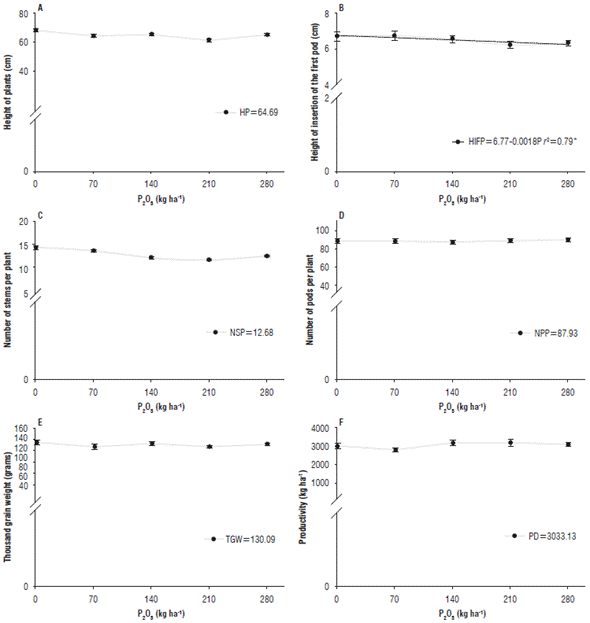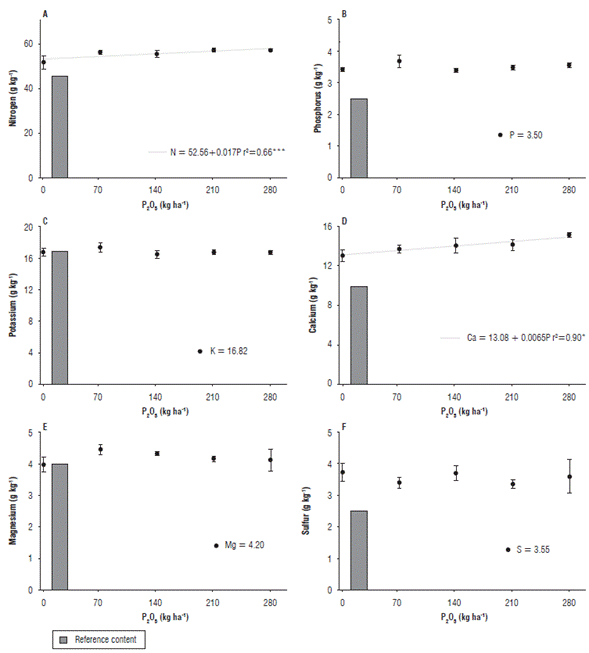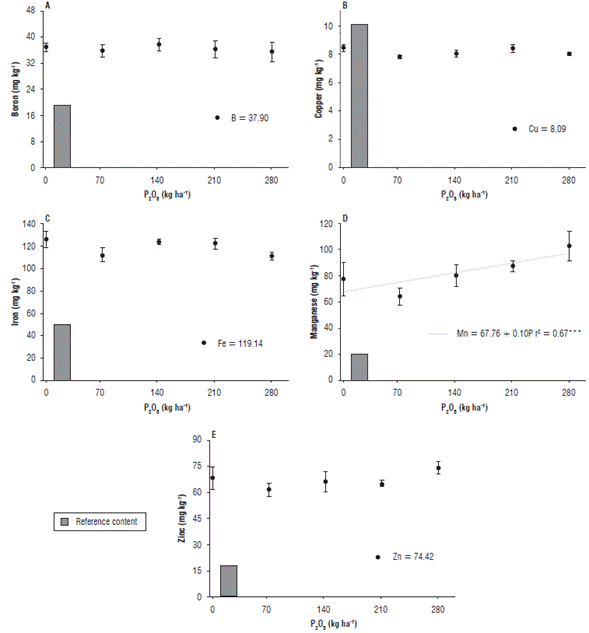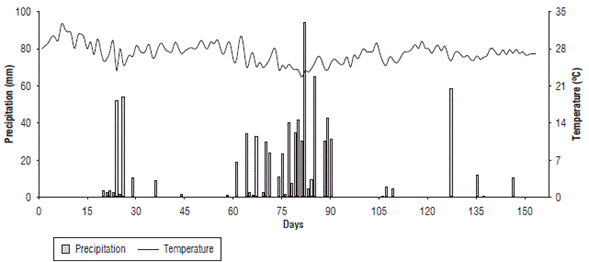Introduction
Soybean (Glycine max L.) is one of the main crops worldwide and recently one of the most growing productive crops in Brazil (Conab, 2018). The Cerrado biome, considered a region of low natural fertility and economic value until 1970, is currently the main soy producing region in the country (Leite et al., 2017; Trabaquini et al., 2017).
The outstanding results of soybean cultivation in the Brazilian Cerrado are due to the government incentives, genetic improvement and application of amendments and fertilizers; since these soils are mostly highly weathered and characterized by a low nutrient availability for the plants (Trabaquini et al., 2017; Cattelan and Dall'Agnol, 2018). Among the essential plant nutrients, phosphorus is the element most commonly applied to the soil, because it is the nutrient that most limits the production in this region (Alcântara Neto et al., 2010).
The knowledge about the chemical limitations in Brazilian Cerrado soils, such as fixation in mineral colloids and by specific adsorption of phosphorus to Fe and Al oxides (Roy et al., 2017), made phosphate fertilization a routine for producers in this region. However, the execution of this practice over the years, along with the management and fertilization of other necessary nutrients, have made possible to modify the chemical, physical and biological properties of the soil, promoting the construction of soil fertility (Lacerda et al., 2015).
Santos et al. (2015) mentioned the fact that plants, such as soybean, present the potential to reuse the residual nutrients from previous fertilizations, thus, presenting low response to phosphate fertilization throughout the years of cultivation. Along with these factors, the excess of certain nutrients can affect the growth and productivity of the plants (Trabaquini et al., 2017).
Facing the changes in most of the soils of the Brazilian Cerrado over the years and the fact that producers continue the application of high doses of phosphate fertilizers, the objective of this study was to evaluate the performance of soybean in response to phosphate fertilization in soils with improved fertility.
Materials and methods
The study was carried out during the 2015-2016 harvest season in a dry land area in the municipality of São Desidério, Bahia (12°40'02״ S and 45°57'47" W). The climate of the region is type Aw (hot and humid), according to the Köppen International Classification (Alvares et al., 2013). The soils of the experimental area present a Sandy Loam texture (Tab. 1), and according to the soil taxonomy keys are classified as Oxisols.
TABLE 1 Chemical and physical soil analysis of the experimental area at 0-20 cm depth.

Available phosphorus (P) and potassium (K) extraction with Mehlich-1; exchangeable calcium (Ca), magnesium (Mg) and aluminum (Al) extraction with KCl; H + Al extraction with calcium acetate.
The experiment was arranged in randomized blocks, with five treatments and four replicates. The treatments were composed of different doses of phosphate fertilizer (0, 70, 140, 210 and 280 kg ha-1 of P2O5). The fertilization was carried out according to each treatment, with application in the planting row. Micronutrients were applied to the soil at the moment of sowing.
The sowing was carried out on November 11, 2015, with a mechanical seeder in an area under conventional planting system and using the cultivar M8349 IPRO*. The plant emergency occurred on December 4, 2015, with a final population of approximately 130,000 plants ha-1. Temperature and precipitation data were collected during the experimental period (Fig. 1).
Cultural management practices were performed according to the recommended baselines for soybeans in the Cerrado (Lopes, 2013). Weeds, pests and diseases were managed through applications of herbicides, insecticides and fungicides registered for the crop. During the phenological stages V3, V7 and R1 micro foliar Manganese was applied. The harvest was performed manually on January 4, 2016, removing 3 replicates of 2 representative linear meters of the plot, excluding the borders.
The following variables were evaluated: Plant height (HP) and height of insertion of the first pod (HIFP) were determined through direct measurement using a ruler graduated in millimeters. The number of stems per plant (NSP) and number of pods per plant (NPP) were determined through the manual counting of these indicators in the sampled plants. The weight of a thousand grains (WTG) was determined on a precision scale. The productivity (PD) was determined based on the grain yield of the plants harvested in each experiment and adjusted to 13% humidity, being corrected from the spacing and quantity of plants per linear meter and transformed to kg ha-1. During the reproductive stage R1 (flowering plants), the third leaf was collected from the main apex of approximately 30 plants per treatment (Sousa and Lobato, 2004). Leaves were then packaged in paper bags identified according to the treatment and sent to the Laboratory of Plant Analysis of the Federal University of Tocantins for the determination of the macro and micronutrients content in leaves.
Initially, the data were tested for normality (Shapiro-Wilk) and homoscedasticity (Levene) and subsequently submitted to regression analysis, evaluating the significance of the betas and the determination coefficients to obtain the appropriate regression model, adopting a 5% probability.
Results and discussion
Among the soybean yield variables, only the first pod insertion height was adjusted to the regression model (Fig. 2). The height of plants did not present an adjustment to the regression model, producing plants with an average height of 64 cm, regardless of the applied phosphate dose.

FIGURE 2 Height of plants (A), height of insertion of the first pod (B), number of stems per plant (C), number of pods per plant (D), thousand grain weight (E) and productivity (F) of soybean in response to phosphate fertilization in soil with improved fertility. P<0.05.
The HIFP presented a linear reduction as a function of the increasing doses of P2O5 (Fig. 2B). For each kg of P2O5 applied to the soil, the plants showed a reduction of 0.0018 cm in HIFP. Despite the results, a low amplitude of variation in the plant HIFP (6.76 to 6.26) was observed as a function of the applied doses.
The number of stems presented a similar behavior to plant height with no adjustment to the regression model (Fig. 2C); plants had a mean number of stems around 12.68.
The height of plants and the number of stems presented a positive correlation with grain yield, since they provided a greater number of reproductive structures (Schoninger et al., 2015). The number of pods and the weight of the grains were also directly related to soybean yield. These variables were not altered as a function of phosphate fertilization in soils with improved fertility (Fig. 2). The height of insertion of the first pod had a direct influence on the occurrence of impurities and grain loss. Although it presented a linear reduction as a function of the doses of phosphorus (Fig. 2B), there was a low amplitude of variation (0.5 cm).
The soybean plants showed an average of 87.93 pods per soybean plant, regardless the phosphate dose (Fig. 2D). The non-adjustment of this variable to the regression model evidences the non-influence of phosphate doses on soils with good fertility.
Like the previous variables, the weight of a thousand grains did not fit the regression model (Fig. 2E) with plants presenting an average WTG of 130 g.
As expected, since the productivity indicators showed no adjustment to regression (Fig. 2), the productivity of soybean plants cultivated in soil with good phosphorus fertility did not present an adjustment to the proposed model (Fig. 2F). The average yield of the plants was 3033 kg ha-1, independent of the phosphate dose applied to the soil.
When evaluating soybean yield in response to phosphate fertilization in Cerrado soils with high phosphorus availability, Santos et al. (2015) found an increase in productivity as a function of the applied doses. However, the increase in productivity (6%) is low in comparison to the high applied dose (389 kg ha-1 of P2O5), not being a viable practice as recommended by Lacerda et al. (2015).
In accordance with the results of this work, Lacerda et al. (2015) studied corn and soybean cultivation in Cerrado soils with high fertility and concluded that it is possible to grow soybeans for three consecutive crops without the use of phosphate fertilization and maintaining P levels in the soil. These authors carried out studies in a consolidated agricultural region in the country, but our study evaluated the behavior in the region denominated as the most recent Brazilian agricultural frontier (Leite et al., 2017).
Regarding the foliar levels of macronutrients of plants as a function of phosphate fertilization, only the levels of nitrogen and calcium were adjusted to the regression analysis (Fig. 3). All leaf mean values were compared to the minimum concentration levels for nutrients in soybean plants grown in the Brazilian Cerrado (Sousa and Lobato, 2004).

FIGURE 3 Leaf macronutrient contents: nitrogen (A), phosphorus (B), potassium (C), calcium (D), magnesium (E) and sulfur (F) in soybean plants with phosphate fertilization.
The plants without phosphorus application presented an average content of 52.56 g kg-1 of N. From these values, the plants fertilized with phosphorus presented an increase of 0.017 g kg-1 of N for each kg of P2O5 applied to the soil. All doses presented leaf N levels above the reference level.
The average levels of leaf phosphorus did not adjust to the regression model as a function of the fertilizer applied to the soil (Fig. 3B). The results showed that there is no greater accumulation of this nutrient in the plant due to the increase of the doses in soil with good fertility.
For the content of foliar potassium, there was no adjustment to the regression as a function of the phosphorus doses applied (Fig. 3C). The mean leaf potassium content was 16.82, which ranged in the appropriate levels for soybean.
Regarding the foliar calcium contents in response to the phosphate doses, they presented an adjustment to the linear model increase (Fig. 3D). For each kg of P2O5 applied to the soil, the plants had an increase of0.0065 g kg-1 Ca in the leaf. Despite the increase in Ca, even plants without fertilizer application presented a foliar Ca level above the suitable level for soybean cultivation in the Brazilian Cerrado.
Magnesium and sulfur leaf contents showed no adjustment to the linear regression (Fig. 3E), producing plants with average leaf contents of 4.20 and 3.55 g kg-1, respectively. For these two nutrients, the plants presented average levels above the appropriate level. In the foliar micronutrient contents, only the manganese was adjusted to the regression (Fig. 4). Leaf boron content in the plants was 37.90 mg kg-1 (Fig. 4D), being this value above the appropriate minimum level.

FIGURE 4 Leaf micronutrient contents: boron (A), copper (B), iron (C), manganese (D) and zinc (E) in soybean plants with phosphate fertilization.
As in the case of boron, copper and iron contents did not adjust to the regression (Fig. 4B and C). However, the leaf content of copper was below the appropriate minimum level for the crop which was different from the behavior of all other foliar nutrients (Fig. 4B). Iron content in the leaf was above the appropriate minimum level at all doses evaluated.
Copper contents in the leaf were below adequate levels at all doses evaluated (Fig. 4B). The average copper leaf content found (8.09 mg kg-1) ranged below the levels of soybean plants from high productivity crops in Brazil and the United States (Mascarenhas et al., 2013). The deficiency of this micronutrient causes a reduction in the growth of soybean plants (Bruns, 2017), directly affecting the yield of the crop (Dimkpa et al., 2017). Although agricultural pesticides commonly used in soybeans, mainly fungicides, have copper in their formulations (Bruns, 2017), Brazilian Cerrado soils are deficient in this nutrient (Marques et al., 2004).
Foliar manganese was 67.76 mg kg-1 in the absence of phosphate fertilizer; however, with the fertilizer application, the plants presented an increase of 0.1 mg kg-1 of Mn to each kg of P2O5 applied to the soil (Fig. 4D).
Regarding zinc, although there was no adjustment to regression, leaf contents of these micronutrients were verified above the minimum suitable level for soybean cultivation at all doses (Fig. 4E).
Evaluating the ideal levels of nutrients for the soybean cultivation in the Brazilian Cerrado (Sousa and Lobato, 2004), the studied soil has an adequate fertility for cultivation (Tab. 1), which reinforces the idea of soil with improved fertility. Such high fertility in these soils occurs because Brazilian agricultural fields received more phosphate fertilizers than necessary for the need of crops, a practice that has been carried out since 1970 (Roy et al., 2017; Withers et al., 2018) and that has consequently accumulated large reserves of phosphorus in the soil.
This research is innovative, since besides studying the productivity of soybean under phosphate fertilization, we also studied the possibility of translocation and nutrient uptake problems in plants due to the high level of phosphorus in the soil associated with doses of phosphate fertilizer. However, even at the highest phosphate doses studied, the plants did not present deficiency of macro and foliar micronutrients except for copper (Figs. 3 and 4). These results are important because micronutrient deficiency can significantly reduce plant quality and productivity (Sutradhar et al., 2017).
It is known that global phosphorus reserves are a finite and critical natural resource. Since Brazilian phosphate rock mines provide limited amounts of phosphorus, phosphate fertilizers are mostly imported, which makes Brazilian agriculture vulnerable to future phosphorous shortage and sudden price fluctuations (Withers et al., 2018).
In order to consider Brazilian agricultural systems as sustainable in the future, it is necessary to use phosphate fertilizers more efficiently (Withers et al., 2018). When considering the amount of phosphorus immobilized in the plant grains (Sousa and Lobato, 2004) the level of phosphorus in the studied soil (Tab. 1) would enable the cultivation of soybeans during three consecutive harvests without the practice of phosphate fertilization. This would allow obtaining the same productivity found (3033 kg ha-1) and still maintaining high nutrient levels in soil. From the third harvest on, phosphorus should be applied in replacement to the immobilized amounts of this nutrient by the grains of the plants (5-8 kg t-1 of grain produced), to maintain the level of phosphorus in the soil.
Conclusions
It was observed that phosphate fertilization for soybean production was not necessary in soil with a high content of available phosphorus.
Despite the non-response to productivity, high doses of phosphate fertilization did not affect nutrient uptake in plants.
Under the conditions of this experiment, phosphorus fertilization in soil with improved fertility does not promote productivity.
















